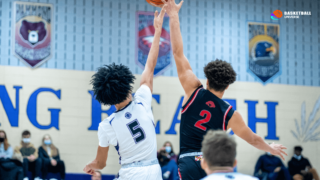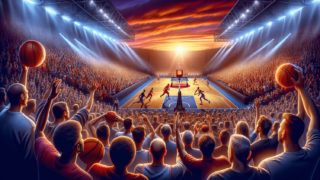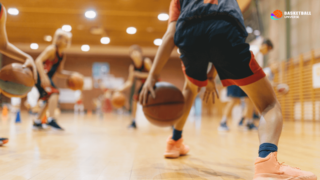
Evolution of Basketball’s Greatest Duos and Trios
Written by: Basketball Universe
Last updated:

As the game of basketball has evolved, so have its legendary partnerships: dynamic duos and titanic trios that have left indelible marks on the court and in the hearts of fans worldwide. Fueled by synergy and unparalleled talent, these exceptional athletic alliances have left a trail of crushed opponents, shattered records, and unforgettable moments in their wake. Dive in and relish the journey through basketball history, as we uncover the genesis of these captivating collaborations and celebrate the unique skill sets that propelled them to greatness. From unbreakable bonds on the hardwood floor to powerhouses revolutionizing the sport, you’ll soon bear witness to the spectacular evolution of basketball’s greatest duos and trios.
Evolution of Basketball’s Greatest Duos and Trios
The evolution of basketball’s greatest duos and trios can be traced back to the early days of the NBA when iconic pairings like Bill Russell and Bob Cousy set the stage for an era of exceptional teamwork. As the league expanded and advanced, other remarkable partnerships emerged, such as Magic Johnson and Kareem Abdul-Jabbar in the 1980s, or Michael Jordan and Scottie Pippen in the 1990s. Continuing to mold the landscape of the sport, contemporary tandems like LeBron James and Dwyane Wade, along with dominant trios like the Golden State Warriors’ “Splash Brothers” and Kevin Durant, have illustrated the ever-evolving nature of basketball collaborations. This evolution reflects not only the players’ individual skills and chemistry but also their adaptability to the game’s constantly shifting styles and strategies.
The Roots: A Basketball History Lesson on Duos and Trios
The foundations of basketball’s legendary partnerships can be traced all the way back to the sport’s early years. These formative duos and trios have left a lasting legacy on the NBA scene, setting the stage for generations to follow.
Bill Russell and Bob Cousy
Bill Russell and Bob Cousy established one of the first and most successful NBA duos in the 1950s and 1960s. Their partnership was the backbone of the Boston Celtics’ dominance during that period. Together, they captured 6 NBA Championships and helped transform the team into a powerhouse that would claim a total of 11 titles in 13 seasons. Russell’s shot-blocking and rebounding prowess perfectly complemented Cousy’s playmaking abilities, creating a formidable partnership that would shape basketball history.
Wilt Chamberlain and Jerry West
Another renowned tandem in the late 1960s and early 1970s was Wilt Chamberlain and Jerry West of the Los Angeles Lakers. Wilt “The Stilt” Chamberlain dominated the paint, consistently producing exceptional stats, while Jerry West’s sharpshooting and incredible offensive capabilities made him an unstoppable force. Their unmatched talent and teamwork led the Lakers to an NBA Championship in 1972, further cementing their legacy.
80s and 90s: A New Breed of Duos and Trios Emerges
As the 1980s and 1990s rolled in, the NBA was blessed with a new breed of exceptional athletes, leading to the emergence of iconic basketball partnerships.
Magic Johnson and Kareem Abdul-Jabbar
No conversation about basketball duos is complete without mentioning Magic Johnson and Kareem Abdul-Jabbar. Their stellar partnership, which spanned much of the 1980s, earned the Los Angeles Lakers the nickname “Showtime” due to their fast-paced and highly entertaining gameplay. Magic’s exceptional vision and passing skills combined with Kareem’s skyhook and scoring abilities to deliver five NBA championships for the Lakers. The duo’s success remains a testimony to the power of teamwork on the court.
Michael Jordan and Scottie Pippen
In the 1990s, the Chicago Bulls saw the rise of perhaps the most iconic duo in NBA history. Michael Jordan, arguably the greatest player of all time, found a perfect partner in Scottie Pippen. The pair displayed a winning combination of scoring, defense, and killer instinct that brought the Bulls an incredible two three-peats (1991-1993 and 1996-1998). Their partnership, emphasized by their telepathic on-court chemistry, set the standard for future duos while capturing the hearts of basketball fans everywhere.
San Antonio Spurs’ “Big Three”
A notable trio that symbolizes the evolving nature of basketball collaborations is the San Antonio Spurs’ “Big Three.” Comprising Tim Duncan, Tony Parker, and Manu Ginóbili, this triumvirate began its reign in the early 2000s, lasting until 2018. The trio won four NBA titles together, showcasing the value of chemistry, consistency, and selflessness. Their international origins – Duncan from the US Virgin Islands, Parker from France, and Ginóbili from Argentina – also broke traditional barriers, illustrating the growing globalization of basketball.
Modern-Day Game Changers
In recent years, we’ve seen the birth of even more astonishing partnerships, helping to redefine what it means to be a dynamic duo or trio in the NBA.
LeBron James and Dwyane Wade
LeBron James and Dwyane Wade’s decision to team up on the Miami Heat in 2010 was not just about merging two superstars but about building a lasting collaboration that would change the NBA’s landscape. Utilizing their exceptional abilities – LeBron’s all-around excellence and Wade’s adaptability – they captured two consecutive titles (2012 and 2013). Their on-court chemistry extended beyond the hardwood, with both players developing a genuine friendship that continues today.
The Golden State Warriors’ “Splash Brothers” and Kevin Durant
Another formidable trio emerged in the form of the Golden State Warriors’ Stephen Curry, Klay Thompson, and Kevin Durant. Nicknamed the “Splash Brothers,” Curry and Thompson had already established themselves as one of the deadliest shooting duos in NBA history. The addition of Durant elevated the Warriors to a new level, leading to back-to-back championships in 2017 and 2018. Curry’s long-range shooting, Durant’s versatility, and Thompson’s lockdown defense represented a remarkable blend of talent that redefined the meaning of a basketball super team.
Rising Duos and Trios to Watch
As the NBA continues to evolve, it’s crucial to keep an eye on emerging partnerships. Here are a couple of rising duos and trios that promise to electrify the basketball world:
Joel Embiid and Ben Simmons
The Philadelphia 76ers have undergone a significant rebuild in recent years, fueling the growth of a dynamic duo: Joel Embiid and Ben Simmons. The talented pair, showcasing Embiid’s dominant post play and shot-blocking prowess alongside Simmons’ elite playmaking and defensive abilities, has the potential to become one of the league’s most formidable partnerships. Their growth and success will ultimately depend on their ability to adapt and complement one another’s skills.
The Brooklyn Nets’ “Big Three”
In the 2020-2021 NBA season, the Brooklyn Nets assembled a powerful and star-studded trio featuring Kyrie Irving, James Harden, and Kevin Durant. Their combination of elite scoring, ball-handling, and playmaking has quickly become a force to be reckoned with in the league, solidifying the Nets as championship contenders. With each player’s high-level skills and individual accolades, it’s important to watch how they continue to mold their chemistry and adapt their games as they chase NBA titles.
Final Thoughts: The Ever-Evolving Art of Duos and Trios
The evolution of basketball’s greatest duos and trios has been an essential part of the sport’s development. From early trailblazers like Russell-Cousy to modern pairings such as LeBron-Wade, these partnerships have redefined strategies and styles of play, ultimately enriching basketball with unforgettable moments and legacies. The future promises even more thrilling and unanticipated collaborations, each shaping the game in its unique way. The phenomenon of duos and trios serves as a testament to the teamwork and chemistry integral to the beautiful game of basketball, ensuring that the sport’s future remains enthralling and ever-evolving.
Factors Influencing the Formation of Duos and Trios
Several key factors play a role in birthing the iconic duos and trios in basketball history. Understanding these elements can provide valuable insights into the reasons behind the most successful partnerships and how teams continue to assemble winning combinations.
Acquiring Talent Through the Draft
One of the most crucial aspects of cultivating a strong partnership is drafting players with great potential. A prime example is Michael Jordan and Scottie Pippen, where Jordan was drafted by the Chicago Bulls in 1984, and Pippen joined the team in 1987. This allowed the Bulls to construct a winning formula built around their two young stars. Similarly, the Oklahoma City Thunder drafted Kevin Durant, Russell Westbrook, and James Harden in consecutive years, although the trio ultimately disbanded due to salary cap constraints.
Building Chemistry and Trust
Great partnerships develop through the growth of chemistry and trust both on and off the court. Successful duos and trios not only possess individual talent but also an innate ability to understand each other’s games, strengths, and weaknesses. This chemistry is built through hours of practice, open communication, and a strong commitment to teamwork, elevating each player’s game to new heights.
Effective Coaching and Management
The foundation of a great duo or trio also requires an effective coaching staff and management to bring out the best in their players. Wise coaching decisions, such as implementing systems that complement the stars’ playstyles, can make all the difference. For instance, the Golden State Warriors’ revolutionary small-ball approach under Head Coach Steve Kerr maximized the potential of Stephen Curry, Klay Thompson, and Kevin Durant. Additionally, the influence of front office executives and general managers in talent acquisition and team building cannot be overstated.
Adapting to System and Style Changes
As the game of basketball evolves, so must its players. Duos and trios that can adapt their games to shifting strategies and styles of play ultimately find success. LeBron James and Dwyane Wade, for example, had to learn to share the ball and synchronize their unique talents to maximize their effectiveness and achieve championship success. Meanwhile, the San Antonio Spurs’ persistence to adapt their game through different eras led to the sustained success of their “Big Three” – Tim Duncan, Tony Parker, and Manu Ginóbili.
Significance of Duos and Trios in Modern NBA
Exploring why duos and trios have become increasingly important in today’s NBA sheds light on their growing prominence in the league.
Superstar-Driven League
Success in the modern NBA often hinges on acquiring and building around superstar talent. However, the days where a solo superstar could singlehandedly dominate the league have become less frequent. Thus, forming formidable duos or trios helps ensure that superstars have the necessary supporting cast to challenge for championships.
Increased Player Mobility
Free agency, player empowerment, and shorter contracts have all contributed to the rise of short-term “super-teams” built around All-Star talent. This has led to a wave of powerful duos and trios, such as the Miami Heat’s LeBron James, Dwyane Wade, and Chris Bosh in 2010, or the recent formation of the Brooklyn Nets’ Kyrie Irving, James Harden, and Kevin Durant.
Emphasis on Positionless Basketball
As the game continues to evolve, traditional positional roles have given way to positionless basketball, where players are expected to fulfil multiple roles on the court. This change has encouraged the formation of versatile and multi-talented partnerships like the Golden State Warriors’ Curry, Thompson, and Durant, capable of fluidly adjusting their games to various system changes and personnel matchups.
Impact on Basketball’s Future
Understanding the significance of basketball’s greatest duos and trios and the factors that contribute to their formation provides a glimpse into the future of the sport.
Globalization of Basketball
The growing influence of international players in the NBA, as evidenced by the San Antonio Spurs’ Tim Duncan, Tony Parker, and Manu Ginóbili, marks the steady globalization of basketball. Teams will increasingly look to talent from around the world to create their unique duos and trios, diversifying the league’s landscape and expanding its fanbase.
The Next Generation of Duos and Trios
As duos and trios continue to play an essential role in shaping the NBA’s future, fans eagerly await the arrival of
FAQ: Basketball’s Greatest Duos and Trios
Here’s a list of frequently asked questions related to the evolution and significance of basketball’s greatest duos and trios. Get all the essential answers to quench your curiosity about these outstanding collaborations in the world of basketball.
1. What defines a great duo or trio in basketball?
A great duo or trio in basketball is defined by a combination of individual talent, on-court chemistry, and the ability to complement each other’s strengths to achieve team success. These partnerships often result in team championships and create unforgettable memories for fans.
2. What factors contribute to the formation of successful basketball duos and trios?
Factors that contribute to successful basketball duos and trios include acquiring talent through the draft, building chemistry and trust among players, effective coaching and management, and adapting to system and style changes in the sport.
3. Which duo or trio is considered the most iconic in NBA history?
While several duos and trios have left their mark on the NBA, many regard Michael Jordan and Scottie Pippen as the most iconic duo, primarily due to their six championships and unparalleled on-court success with the Chicago Bulls in the 1990s.
4. How do modern NBA duos and trios differ from those of the past?
Modern NBA duos and trios often come together through free agency, shorter contracts, and increased player mobility. The emphasis on positionless basketball also highlights the importance of multi-talented partnerships that can adapt to various systems and personnel matchups.
5. Are NBA championships always won by teams with a great duo or trio?
While having a great duo or trio increases a team’s chances of winning championships, it is not an absolute requirement. Team depth, chemistry, coaching, and other factors contribute significantly to a team’s success, making it possible for teams without a clear-cut duo or trio to win championships.
6. How has the globalization of basketball impacted the development of duos and trios?
The globalization of basketball has led to an increased presence of international talent in the league, resulting in a more diverse array of partnerships. This global influence ultimately enhances the overall talent pool and competitiveness of the league.
7. Can single superstars still dominate the league without a strong supporting duo or trio?
While there are cases of single superstars carrying their teams deep into the playoffs, it has become increasingly challenging for players to singlehandedly dominate the league in modern times. Forming strong duos and trios with complementary skills and chemistry greatly enhances a team’s chances of success.
8. Why is player chemistry so important in the formation of duos and trios?
Player chemistry is vital in the formation of duos and trios because it allows players to maximize their individual talents and create a seamless on-court dynamic. This results in better team performance and an increased likelihood of achieving success in the league.
9. How have coaching strategies evolved to accommodate the rise of duos and trios?
Coaching strategies have evolved to accommodate duos and trios by emphasizing ball movement, adaptability, and fluidity on the court. Coaches often create tailored systems that play to their stars’ strengths while focusing on fostering chemistry and trust among the players.
10. Which upcoming duos and trios should basketball fans look out for in the near future?
Upcoming duos and trios to watch include Joel Embiid and Ben Simmons of the Philadelphia 76ers and the Brooklyn Nets’ “Big Three” – Kyrie Irving, James Harden, and Kevin Durant. These partnerships offer an exciting blend of talent and chemistry, poised to shape the landscape of the NBA for years to come.
Featured Posts
- No pillar pages found.





